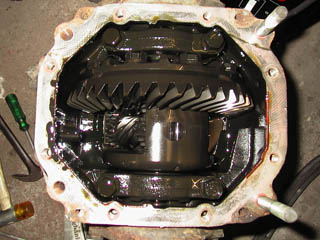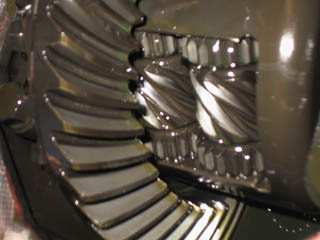Torsen LSD info and pics
Here's more info about the G319 Torsen LSD I got with the engine.
It came from a JZA70 Supra (1JZ-GTE). I want to install it in a solid
rear axle and use it in my 1JZGTE -> TA23 project, but that's a
different story.
What's a Torsen LSD?
A Torsen LSD is a mechanical LSD, built from gears only. It does not have
clutches that can wear out. It doesn't require LSD specific oil either, it
will run happily on regular gear oil. The famous "jack up and spin one wheel"
test does not work for a Torsen LSD - the axle code really is the only way
to identify it without opening it up.
How does it work?
This paragraph assumes you know how a standard open diff works. If you
don't, look
here.
It's all based on one principle - that a worm gear cannot backdrive its
worm. See what I mean? Then skip to the next paragraph, because I will
now explain roughly what a worm is.
Picture a gear with very fine teeth, the size of bolt threads. Now add
a bolt, and have its threads hook up with the gear teeth. Hold the bolt
steady and spin it. It will drive the gear, right? Okay, now try turning
the gear. It'll seem locked - you will not succeed in making it spin the
bolt. That's the principle of a worm gear. The amount of "back-drive"
possible depends on the "spiral angle" of the worm, which is near
zero in this (bolt) example. The driven gear is normally angle cut to match
the worm's spiral angle (for good contact between gear teeth and worm).
A Torsen LSD consists of three pairs of worms, like a normal diff
has 2 or 4 pinion gears. The worms in each pair are connected by normal
straight cut gears, and the worms themselves drive the side gears.
(note : in a normal diff one pinion gear drives both side gears. In
a torsen diff, they are driven by a pair of worms, one for
each side gear)
Now if one wheel is losing traction, it will try to spin faster than
the other. To make this possible, the worms will have to spin. Now
because the worms will resist being driven by the side gears, speed
difference between the wheels is limited : we got an LSD!
This story could use a few drawings to clarify it. I am no artist
though - Any volunteers?
Uhhh...okay...but I don't get it...can I see a picture?
Sure. Here's two. Click to enlarge to 640x480 :

 You can see one pair of worms on these pictures. There are two
more pairs of worms, you'll have to take my word for that :-)
Each pair is connected by small straight cut gears on each end.
Straight cut? But aren't straight cut gears really noisy? Yes
they are, but only when spinning! If both wheels turn at the
same speed (like they do 99% of the time during normal driving),
the worms just sit there, just like the pinions in a normal diff.
You can see one pair of worms on these pictures. There are two
more pairs of worms, you'll have to take my word for that :-)
Each pair is connected by small straight cut gears on each end.
Straight cut? But aren't straight cut gears really noisy? Yes
they are, but only when spinning! If both wheels turn at the
same speed (like they do 99% of the time during normal driving),
the worms just sit there, just like the pinions in a normal diff.
Also note the worms have a quite steep "spiral angle". If they
didn't, the LSD would be much tighter. Why? Well, you should be
able to figure that out now! See "How does it work?" above.
Cool! Any drawbacks?
Yes. A major one is that it requires *some* traction on both wheels
to work well. If you can't apply much torque to begin with, it won't
work at all. That's also why the "jack up and spin one wheel" test
doesn't work: the other wheel will happily spin in the other
direction as if it were an open diff. A Torsen LSD has a torque bias
ratio. It means if the torque bias ratio is 4:1, it can apply a
maximum of 4 times the loose wheel's torque on the wheel with
traction. This means, if you have one wheel off the ground, you're
still going nowhere with a Torsen. 4 times zero is still zero. One
quick fix if you're stuck is to apply the brakes. With the Torsen
working against the brakes, it will transfer 4 times the braking
force to the wheel on the ground.
Seems to me this doesn't matter at all for street/track use, where
you seldom deal with zero traction situations. Others can probably
tell you in more detail what type of LSD is best for what type of
use. I don't know enough about racing for that.
And the pros?
Well, of course it doesn't wear out - like many of the used clutch
type LSDs you can buy already have. Also no need for LSD specific
oil. And, especially with not much power applied, it will operate
smoothly: no understeer effects when you don't want them.
That of course doesn't matter for the drags, but there may be a
benefit in road racing or autocross. Again : others can fill in
the blanks here.
Link
More information about the benefits and history of Torsen
differentials can be found
here
Send questions/comments/complaints to
me. No copying without
asking first.



